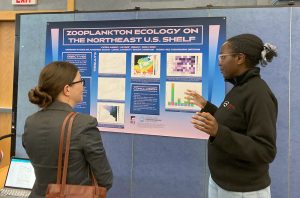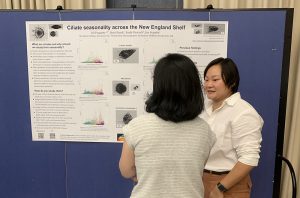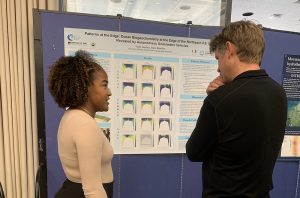Undergraduate students present research on the Northeast U.S. Shelf ecosystem
This summer the Northeast U.S. Shelf Long-Term Ecological Research (NES-LTER) project hosted three undergraduate researchers in Woods Hole. All three presented posters at Woods Hole Oceanographic Institution (WHOI)’s annual summer student poster symposium held on August 10, 2023.
 Victoria Abunaw, a rising senior in Earth and Atmospheric Sciences at Cornell University, participated in WHOI’s Summer Student Fellowship (SSF) program. Mentored by Mei Sato and Rubao Ji, with assistance of NES-LTER graduate student Isabel Honda, Victoria analyzed zooplankton abundance and CTD data from NES-LTER Transect cruises to identify ecological trends and their drivers in the zooplankton community of the Northeast U.S. Shelf ecosystem. Along with co-authors, Victoria presented statistical analyses and representative visualizations in a poster: “Zooplankton ecology on the Northeast U.S. Shelf.”
Victoria Abunaw, a rising senior in Earth and Atmospheric Sciences at Cornell University, participated in WHOI’s Summer Student Fellowship (SSF) program. Mentored by Mei Sato and Rubao Ji, with assistance of NES-LTER graduate student Isabel Honda, Victoria analyzed zooplankton abundance and CTD data from NES-LTER Transect cruises to identify ecological trends and their drivers in the zooplankton community of the Northeast U.S. Shelf ecosystem. Along with co-authors, Victoria presented statistical analyses and representative visualizations in a poster: “Zooplankton ecology on the Northeast U.S. Shelf.”
 Jill Paquette, a rising senior in Biology at Davidson College, participated in WHOI’s SSF program. Jill expanded research that she started last year as an intern in the Woods Hole Partnership Education Program (PEP). Last summer, Jill identified seasonal patterns in abundance of ciliates at the Martha’s Vineyard Coastal Observatory. This summer, we welcomed Jill back into Heidi Sosik’s lab to see if those seasonal patterns held across the shelf. Along with co-authors, Jill presented: “Ciliate seasonality across the New England Shelf.” Jill will continue this research during her independent study and senior thesis at Davidson College.
Jill Paquette, a rising senior in Biology at Davidson College, participated in WHOI’s SSF program. Jill expanded research that she started last year as an intern in the Woods Hole Partnership Education Program (PEP). Last summer, Jill identified seasonal patterns in abundance of ciliates at the Martha’s Vineyard Coastal Observatory. This summer, we welcomed Jill back into Heidi Sosik’s lab to see if those seasonal patterns held across the shelf. Along with co-authors, Jill presented: “Ciliate seasonality across the New England Shelf.” Jill will continue this research during her independent study and senior thesis at Davidson College.
 Taina Sanchez, who participated in PEP, recently graduated from University of Miami with a B.S. in Marine Biology and Ecology. Mentored by Stace Beaulieu and NES-LTER postdoc Bofu Zheng, Taina explored data collected by Autonomous Underwater Vehicles (AUVs) deployed by the Ocean Observatories Initiative (OOI). As one of the first users of OOI’s new format for AUV data as well as OOI’s new JupyterHub computing environment, Taina communicated results to OOI’s Coastal and Global Scale Node (CGSN) Data Science team and posted a Python notebook in GitHub. Taina presented: “Patterns at the edge: Ocean biogeochemistry at the edge of the Northeast U.S. Shelf revealed by Autonomous Underwater Vehicles.”
Taina Sanchez, who participated in PEP, recently graduated from University of Miami with a B.S. in Marine Biology and Ecology. Mentored by Stace Beaulieu and NES-LTER postdoc Bofu Zheng, Taina explored data collected by Autonomous Underwater Vehicles (AUVs) deployed by the Ocean Observatories Initiative (OOI). As one of the first users of OOI’s new format for AUV data as well as OOI’s new JupyterHub computing environment, Taina communicated results to OOI’s Coastal and Global Scale Node (CGSN) Data Science team and posted a Python notebook in GitHub. Taina presented: “Patterns at the edge: Ocean biogeochemistry at the edge of the Northeast U.S. Shelf revealed by Autonomous Underwater Vehicles.”
We’d like to thank WHOI’s Academic Programs Office for sponsoring the poster symposium and WHOI Creative Services for printing posters. Special thanks to Kama Thieler for coordinating WHOI’s SSF program and Onji Scott Price and Monet Murphy for coordinating the PEP.
If you’d like to learn more or apply for next year’s summer programs, please check our webpage https://nes-lter.whoi.edu/education/#undergrad-grad (applications usually are due in February).


